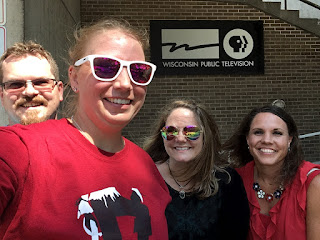PD: Wisconsin First Detector Network: Field Training on Emerald Ash Borer and Invasive Plants
Invasive species is a topic that I'm very passionate about having grown up in a family that has a presence in the horticulture industry. Often customers would bring in samples of plants/insects to Stein Garden Center to have me identify and propose a solution. This was one of my most favorite parts of my job. If I had the opportunity to go back to school I would love to secure a degree in entomology/plant pathology. I have never had the opportunity to witness Emerald Ash Borer damage, so when this training was presented to me I was ALL IN!
The training was held at the Riveredge Nature Center in Saukville, WI. UW-Madison faculty researchers and entomologists came to present their research on control of the EAB. There were two takeaways from the presentation.
1. If you don't treat ash trees they will die.
2. Effective insecticide treatments do exist.
They went on to describe to us the signs & symptoms of EAB and the various homeowner and commercial methods to treating the insect. While biological control is the preferred method of treatment, it does not have the quickest response to prevent the spread of an EAB infestation. We had the opportunity to witness the effect of various treatments and no treatments on trees at the Nature Center.
The second part of the presentation was on Wisconsin Invasive Species. The point was made that an invasive species can be more aggressive in one area than in another. What we may see as "invasive" might not really be invasive, but just extremely aggressive in our area. It is important for us as citizens to get to know our area and be able to recognize "what does not belong." This helps us to identify invasive species relatively quickly before cause significant damage. It is also important to know the "life history" of the plant for control measures. How does it grow? You don't want to spend more time than you need on controlling it, so be familiar with the best management technique possible. After being introduced to a handful of these species, we also had the opportunity to try out the Great Lakes Early Detection Network app that exists for both android and iOS devices. With this app you can participate in a state wide project for locating, identifying, and reporting invasive species. There are many categories of invasives on this app, not just plants. I am planning on introducing this app into a classroom lesson, as well as encouraging students to use it outside of the classroom and for project point opportunities. How exciting to be able to help contribute to a statewide database on the presence of invasive species! I'm excited and I hope my students will be able to share the same excitement.
The training was held at the Riveredge Nature Center in Saukville, WI. UW-Madison faculty researchers and entomologists came to present their research on control of the EAB. There were two takeaways from the presentation.
1. If you don't treat ash trees they will die.
2. Effective insecticide treatments do exist.
They went on to describe to us the signs & symptoms of EAB and the various homeowner and commercial methods to treating the insect. While biological control is the preferred method of treatment, it does not have the quickest response to prevent the spread of an EAB infestation. We had the opportunity to witness the effect of various treatments and no treatments on trees at the Nature Center.
The second part of the presentation was on Wisconsin Invasive Species. The point was made that an invasive species can be more aggressive in one area than in another. What we may see as "invasive" might not really be invasive, but just extremely aggressive in our area. It is important for us as citizens to get to know our area and be able to recognize "what does not belong." This helps us to identify invasive species relatively quickly before cause significant damage. It is also important to know the "life history" of the plant for control measures. How does it grow? You don't want to spend more time than you need on controlling it, so be familiar with the best management technique possible. After being introduced to a handful of these species, we also had the opportunity to try out the Great Lakes Early Detection Network app that exists for both android and iOS devices. With this app you can participate in a state wide project for locating, identifying, and reporting invasive species. There are many categories of invasives on this app, not just plants. I am planning on introducing this app into a classroom lesson, as well as encouraging students to use it outside of the classroom and for project point opportunities. How exciting to be able to help contribute to a statewide database on the presence of invasive species! I'm excited and I hope my students will be able to share the same excitement.



.JPG)
Comments
Post a Comment